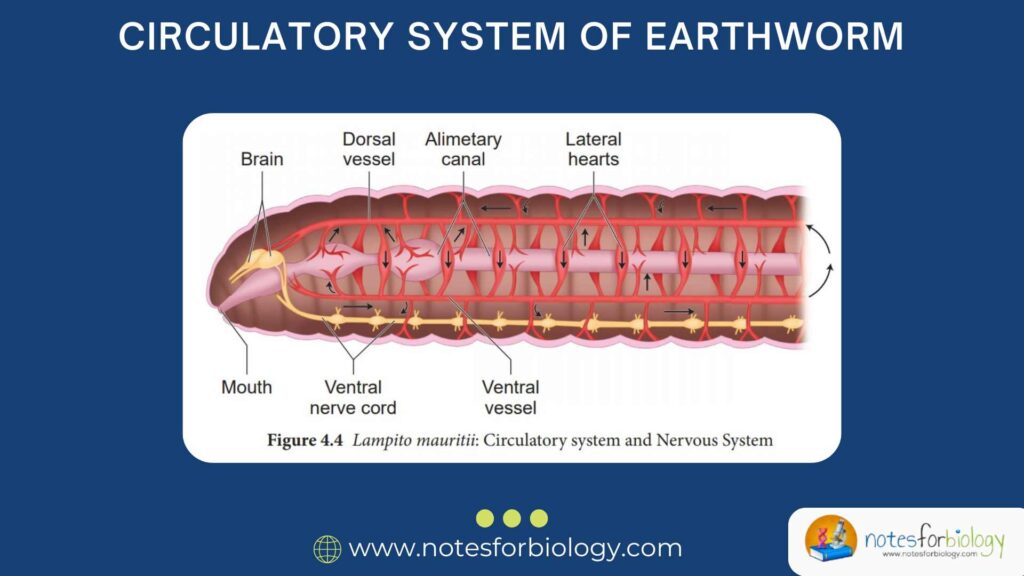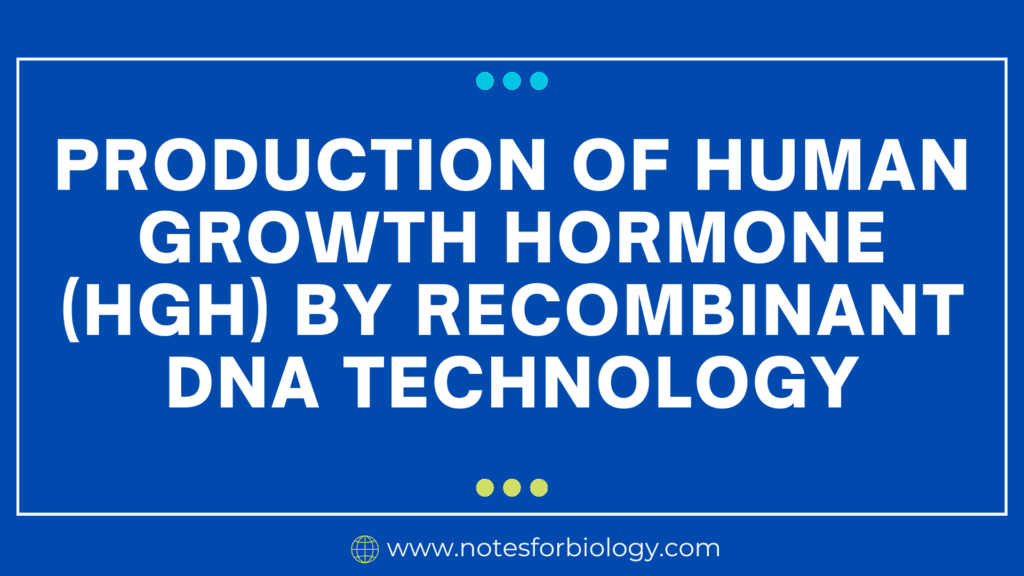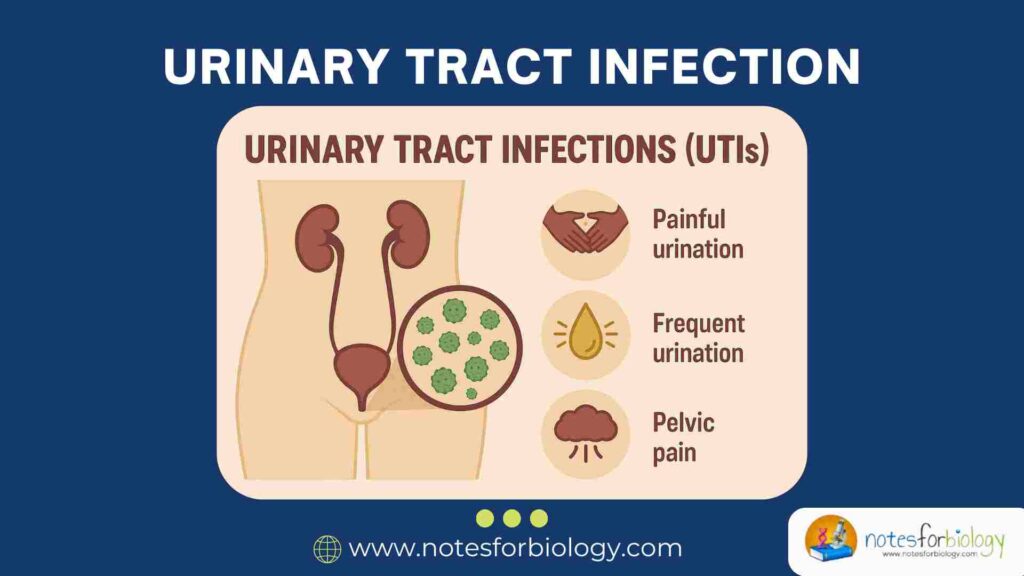Introduction
The circulatory system is a transport system that moves nutrients, gases, hormones, and waste products throughout the body. In earthworms, it plays a crucial role in maintaining life processes, even though they lack complex organs like a heart or lungs. The earthworm may seem like a simple, lowly creature squirming through the soil, but its internal systems—especially its circulatory system—are surprisingly organized and efficient. Earthworms belong to the phylum Annelida, and they have a closed circulatory system, just like humans. This means that the blood flows within a network of vessels, not freely in the body cavity.
In this article, we will explore everything about the circulatory system of the earthworm, including its structure, functioning, types of blood vessels, the role of blood, respiratory pigments, and how circulation supports its survival in the soil.
Table of Contents
What is a Circulatory System?
The circulatory system is a transport system that moves nutrients, gases, hormones, and waste products throughout the body. In earthworms, it plays a crucial role in maintaining life processes, even though they lack complex organs like a heart or lungs.
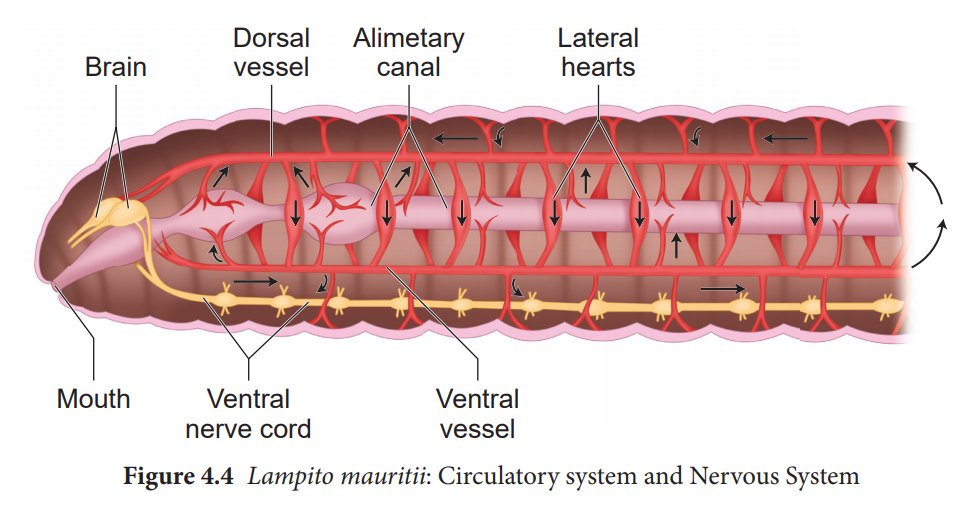
Earthworms use this system to transport:
- Oxygen and carbon dioxide
- Nutrients from digested food
- Excretory wastes
- Hormones
Type of Circulatory System in Earthworm
Earthworms have a closed circulatory system. This means:
- Blood is enclosed within vessels at all times.
- There is directional flow—the blood flows in a definite path and does not mix with body fluids.
- It ensures efficient transport and maintains higher blood pressure than an open system.
This is different from insects (like cockroaches) that have an open circulatory system, where blood freely bathes organs in the body cavity.
Main Components of Circulatory System in Earthworm
The earthworm’s circulatory system includes:
- Blood vessels
- Hearts or aortic arches
- Capillaries
- Blood
- Blood cells and pigments
Let’s break them down in detail.
1. Blood Vessels
There are three main types of blood vessels in earthworms:
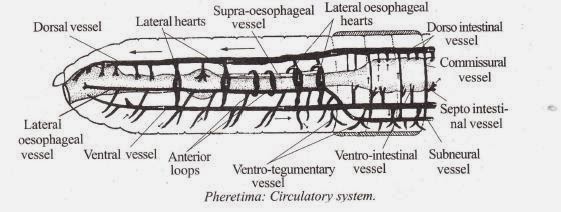
a. Dorsal Blood Vessel
- Runs along the back (dorsal side) of the worm.
- It is the main collecting vessel.
- Blood flows anteriorly (from the back towards the front).
- Acts like a suction pump, pulling blood from the body and pushing it forward.
b. Ventral Blood Vessel
- Runs along the belly (ventral side) of the worm.
- It is the main distributing vessel.
- Blood flows posteriorly (from the front to the back).
- Supplies blood to body organs via side branches.
c. Lateral (or Commissural) Blood Vessels
- These connect the dorsal and ventral blood vessels.
- Include the hearts (aortic arches).
- They help pump blood and regulate flow.
2. Aortic Arches (Hearts)
Earthworms have five pairs of hearts (also called aortic arches).
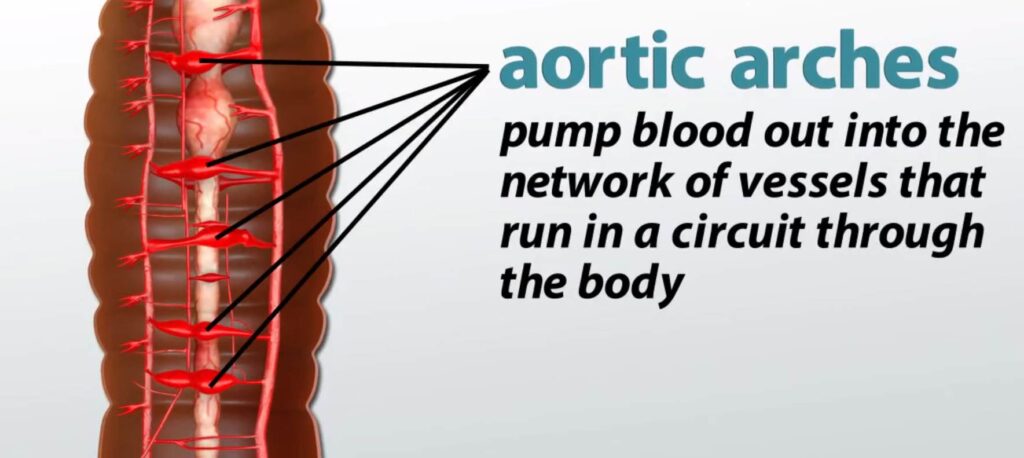
- Located around the esophagus (in segments 7 to 11).
- These are muscular, contractile loops.
- They pump blood from the dorsal vessel into the ventral vessel.
- Though not a “heart” in the human sense, they perform a similar pumping function.
3. Capillaries
These are tiny blood vessels that form a network between arteries and veins.
- Capillaries reach into the body wall, gut, and skin.
- This is where exchange of gases (O₂/CO₂), nutrients, and waste occurs.
- Oxygen is absorbed through the skin, enters the capillaries, and gets transported.
4. Blood
Earthworm blood is red in color, like humans.
Why?
Because it contains hemoglobin, the same pigment that gives human blood its red color. But there’s a twist:
- In earthworms, hemoglobin is dissolved in the plasma, not inside cells like in humans.
- Blood is made of plasma and blood cells.
5. Blood Cells
Earthworms have two main types of blood cells:
a. Colorless Amoeboid Cells
- These cells move like amoebas.
- They help in engulfing foreign particles and fighting infections.
- Function like white blood cells (WBCs) in humans.
b. Nucleated Red Cells (with hemoglobin)
- These are not true “RBCs” like in humans.
- They assist in transporting oxygen and carbon dioxide.
- But most of the hemoglobin is dissolved in plasma, not in the cells.
How Does Circulation Work in Earthworms?
The circulatory process in earthworms follows a closed-loop system:
- Blood is pumped by the aortic arches (hearts) from the dorsal to the ventral vessel.
- From the ventral vessel, blood is distributed to all parts of the body.
- Capillaries deliver oxygen and nutrients and collect carbon dioxide and waste.
- The used blood returns via the dorsal vessel.
- The cycle continues, ensuring a constant supply of oxygen and nutrients.
Direction of Blood Flow
- Dorsal vessel: flows anteriorly (toward the front).
- Ventral vessel: flows posteriorly (toward the back).
- Lateral hearts connect these two and maintain the rhythmic pumping.
Role of Skin in Circulation
Earthworms do not have lungs or gills. Instead, they breathe through their skin.
- Their skin must remain moist for gas exchange.
- Oxygen dissolves in the moisture, diffuses into the capillaries under the skin.
- Carbon dioxide diffuses out in the same way.
- The circulatory system picks up this oxygen and delivers it to body cells.
So, the skin acts as a respiratory surface, and the circulatory system transports the gases.
Why is Closed Circulation Important for Earthworms?
The closed circulatory system is a major advancement in the evolution of animals. For earthworms, it provides several advantages:
- Efficient oxygen and nutrient delivery to deep tissues.
- Rapid removal of carbon dioxide and wastes.
- Supports higher metabolic activity.
- Allows the worm to be long and segmented without compromising on nutrient supply.
- Maintains a higher pressure, improving circulation speed.
Special Features of Earthworm Circulation
- Multiple hearts: Instead of one heart, they have five pairs, improving circulation.
- Hemoglobin in plasma: Unlike most invertebrates, their hemoglobin is free-floating.
- Skin-based respiration: No lungs needed, making circulation more dependent on capillary action under the skin.
- Segmented vessels: Blood vessels correspond with body segmentation for better distribution.
- Capillary beds: Allow efficient gas and nutrient exchange throughout the body.
Comparison with Other Animals
| Feature | Earthworm | Humans | Cockroach |
|---|---|---|---|
| Circulatory System | Closed | Closed | Open |
| Blood Pigment | Hemoglobin (in plasma) | Hemoglobin (in RBCs) | None |
| Heart | 5 pairs of arches | 1 four-chambered heart | 13 chambers |
| Respiratory Organ | Skin | Lungs | Tracheae |
| Blood Cells | Simple, nucleated | RBCs & WBCs | Absent |
Importance of Circulatory System in Earthworm’s Life
The circulatory system supports various life functions:
- Movement: Supplies energy to muscles for burrowing.
- Digestion: Transports nutrients from gut to tissues.
- Respiration: Carries oxygen from skin to body cells.
- Excretion: Helps remove waste from cells to nephridia (excretory organs).
- Reproduction: Supplies blood to reproductive organs.
Diseases or Disruption in Circulation
Although earthworms are quite resilient, damage to their circulatory system (like injury or dehydration) can lead to:
- Reduced oxygen transport
- Slow movement or sluggishness
- Death if bleeding is severe
- Drying out, which blocks skin respiration, also affects circulation.
That’s why they are more active in moist environments and come out during rain.
Fun Facts
- Earthworm blood is red, not green or blue.
- They can regrow parts, but only if circulation is not critically damaged.
- Without moist skin, even with a perfect circulatory system, they cannot survive.
Conclusion
The circulatory system of the earthworm is a marvel of simplicity and efficiency. With a closed system of blood vessels, multiple “hearts,” and dissolved hemoglobin, the worm manages to support all life activities without lungs or a complex brain.
Through this system, the earthworm achieves proper nutrient distribution, oxygen transport, and waste removal—ensuring survival in the underground world. This system is not just vital but also highlights the beauty of biological design, even in the simplest of creatures.
So, the next time you see an earthworm wriggling in your garden, know that beneath that slimy skin lies a highly organized life-sustaining system at work.
FREQUENTLY ASKED QUESTIONS
What type of circulatory system does an earthworm have?
Earthworms have a closed circulatory system, meaning the blood flows through a network of vessels and does not mix with body fluids.
How many hearts does an earthworm have?
Earthworms have five pairs of aortic arches, commonly referred to as 10 hearts, located in segments 7 to 11. These pump blood and function like hearts.
Does the earthworm have hemoglobin in its blood?
Yes, earthworm blood contains hemoglobin, which is dissolved in the plasma, giving the blood a red color and allowing it to carry oxygen efficiently.
Related Articles

